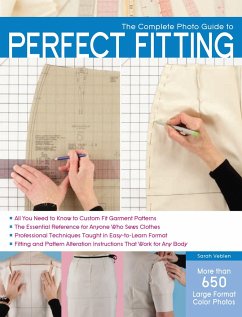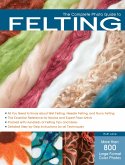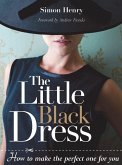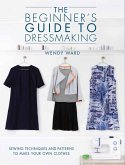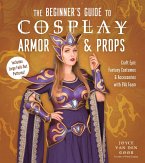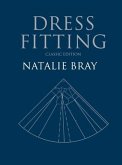Sarah Veblen
The Complete Photo Guide to Perfect Fitting
26,99 €
inkl. MwSt.
Versandfertig in 2-4 Wochen

13 °P sammeln
Sarah Veblen
The Complete Photo Guide to Perfect Fitting
- Broschiertes Buch
- Merkliste
- Auf die Merkliste
- Bewerten Bewerten
- Teilen
- Produkt teilen
- Produkterinnerung
- Produkterinnerung
The Complete Photo Guide to Pattern Fitting is a comprehensive how-to book about altering commercial patterns to customize the fit to one's own body before cutting out fabric and sewing the garment.
Andere Kunden interessierten sich auch für
![The Complete Photo Guide to Felting The Complete Photo Guide to Felting]() Ruth LaneThe Complete Photo Guide to Felting23,99 €
Ruth LaneThe Complete Photo Guide to Felting23,99 €![Kenneth D. King's Smart Fitting Solutions Kenneth D. King's Smart Fitting Solutions]() K KingKenneth D. King's Smart Fitting Solutions29,99 €
K KingKenneth D. King's Smart Fitting Solutions29,99 €![The Little Black Dress: How to Make the Perfect One for You The Little Black Dress: How to Make the Perfect One for You]() S HenryThe Little Black Dress: How to Make the Perfect One for You16,99 €
S HenryThe Little Black Dress: How to Make the Perfect One for You16,99 €![The Beginners Guide to Dressmaking The Beginners Guide to Dressmaking]() Wendy Ward (Author)The Beginners Guide to Dressmaking27,99 €
Wendy Ward (Author)The Beginners Guide to Dressmaking27,99 €![The Complete Beginner's Guide to Embroidery The Complete Beginner's Guide to Embroidery]() Esme ClemoThe Complete Beginner's Guide to Embroidery28,99 €
Esme ClemoThe Complete Beginner's Guide to Embroidery28,99 €![The Beginner's Guide to Cosplay Armor & Props The Beginner's Guide to Cosplay Armor & Props]() Joyce van den GoorThe Beginner's Guide to Cosplay Armor & Props32,99 €
Joyce van den GoorThe Beginner's Guide to Cosplay Armor & Props32,99 €![Dress Fitting Dress Fitting]() Natalie Bray (London Katinka School of DressDesigning)Dress Fitting76,99 €
Natalie Bray (London Katinka School of DressDesigning)Dress Fitting76,99 €-
-
-
The Complete Photo Guide to Pattern Fitting is a comprehensive how-to book about altering commercial patterns to customize the fit to one's own body before cutting out fabric and sewing the garment.
Hinweis: Dieser Artikel kann nur an eine deutsche Lieferadresse ausgeliefert werden.
Hinweis: Dieser Artikel kann nur an eine deutsche Lieferadresse ausgeliefert werden.
Produktdetails
- Produktdetails
- Verlag: Quarto Publishing Group USA Inc
- Seitenzahl: 224
- Erscheinungstermin: 1. Januar 2012
- Englisch
- Abmessung: 207mm x 277mm x 18mm
- Gewicht: 874g
- ISBN-13: 9781589236080
- ISBN-10: 1589236084
- Artikelnr.: 33142438
- Herstellerkennzeichnung
- Libri GmbH
- Europaallee 1
- 36244 Bad Hersfeld
- gpsr@libri.de
- Verlag: Quarto Publishing Group USA Inc
- Seitenzahl: 224
- Erscheinungstermin: 1. Januar 2012
- Englisch
- Abmessung: 207mm x 277mm x 18mm
- Gewicht: 874g
- ISBN-13: 9781589236080
- ISBN-10: 1589236084
- Artikelnr.: 33142438
- Herstellerkennzeichnung
- Libri GmbH
- Europaallee 1
- 36244 Bad Hersfeld
- gpsr@libri.de
Sarah Veblen is a custom fashion designer who focuses on creating clothing for her clientele and on teaching and writing to promote the craft of garment-making. For more than 25 years, Sarah has been designing and making clothing for her private clientele, specializing in fit, innovative pattern design, and quality construction. Her focus is on helping women create a wardrobe that is comfortable and compatible with their lifestyle. Dedicated to promoting sewing at all levels, Sarah enjoys immersing herself into her students’ learning process. She teaches in her studio and other classroom venues, as well as online through PatternReview.com. She is also a frequent guest lecturer and regularly holds workshops for sewing groups and organizations across the country. Sarah has authored many articles and publications on sewing and design, including her books First Time Garment Fitting and The Complete Photo Guide to Perfect Fitting and writes her own blog. She has also made a series of instructional fitting DVDs, produced by Threads magazine, on skirt and bodice fitting and on making stylistic changes to a pattern. Sarah has a Certificate in Fashion Design from Baltimore City Community College and a BA from Stanford University. She is an active member of both the Association of Sewing and Design Professionals (ASDP) and the American Sewing Guild (ASG). She lives in Phoenix, Maryland. See more of her work at sarahveblen.com.
Introduction
Laying the Foundation
Developing a Solid Approach to Fitting
Why Fitting is Complicated
Each Individual is Unique
Pattern and Fitting Basics
How Patterns are Developed
Finding Your Way Around a Pattern
Garment Silhouettes and Ease
Choosing a Pattern Size
Tools for Pattern Work and Fitting
The Interrelationship Between Patterns and Fitting
Overview of the Fitting Process
Recognizing Fitting Issues
A Framework for Fitting
The Fitting Axis
The Horizontal Balance Line
Fundamentals of Fitting Muslins
Learning to Look
The Body as “Volume”
Fitting Others and Yourself
What to Wear for a Fitting
Preparing the Test Muslin for a Fitting
Clipping and Marking During a Fitting
Pinning
Keeping the Muslin Balanced
Fitting Order
Fitting Tips
Assessing the Fit
Fundamentals of Altering Patterns
Glossary of Patternmaking Terms
Making Flat Pattern Adjustments
Transferring Muslin Markings to the Pattern
Blending Seams, Using the Rulers, and Adding Seam Allowances
Lengthening and Shortening Patterns, and Grainline Arrows
Walking and Truing a Pattern
Placing and Creating Notches
Controlling Patterns with Built-in Ease
Truing Difficult Seams
Moving the Placement of a Seam
Moving a Dart to a New Location
Truing Dart Legs
Scaling Patterns Up and Down
Working in an Efficient Order
Developing your Ability
The Process of Fitting Garments
Skirt
Bodice with Darts
Bodice with Shoulder Princess Line
Jacket with Side Panel with Set-in Sleeve
Tunic with Armscye Princess Line
Bodice with Raglan Sleeve
Fitting Solutions for Body Types and Related Pattern Alterations
Bust
Back
Sides
Shoulder Line and Neck
Set-in Sleeves
Raglan Sleeves
Waist and Hips
Fitting Pants
Understanding Body Mass and Pants Volume
Fine-tuning the Fit
The Process of Fitting Pants
Body Type Examples
Typical Pants Pattern Alterations
Going to the Next Level
Correcting Pattern Elements Affected by Fitting Changes
Waistbands
Facings
Collars
Linings
Get Creative
Using Style Lines to Create Pleasing Proportions
Dart Equivalents
Collar Variations
Cuffs and Sleeve Hems
About the Author
Index
Laying the Foundation
Developing a Solid Approach to Fitting
Why Fitting is Complicated
Each Individual is Unique
Pattern and Fitting Basics
How Patterns are Developed
Finding Your Way Around a Pattern
Garment Silhouettes and Ease
Choosing a Pattern Size
Tools for Pattern Work and Fitting
The Interrelationship Between Patterns and Fitting
Overview of the Fitting Process
Recognizing Fitting Issues
A Framework for Fitting
The Fitting Axis
The Horizontal Balance Line
Fundamentals of Fitting Muslins
Learning to Look
The Body as “Volume”
Fitting Others and Yourself
What to Wear for a Fitting
Preparing the Test Muslin for a Fitting
Clipping and Marking During a Fitting
Pinning
Keeping the Muslin Balanced
Fitting Order
Fitting Tips
Assessing the Fit
Fundamentals of Altering Patterns
Glossary of Patternmaking Terms
Making Flat Pattern Adjustments
Transferring Muslin Markings to the Pattern
Blending Seams, Using the Rulers, and Adding Seam Allowances
Lengthening and Shortening Patterns, and Grainline Arrows
Walking and Truing a Pattern
Placing and Creating Notches
Controlling Patterns with Built-in Ease
Truing Difficult Seams
Moving the Placement of a Seam
Moving a Dart to a New Location
Truing Dart Legs
Scaling Patterns Up and Down
Working in an Efficient Order
Developing your Ability
The Process of Fitting Garments
Skirt
Bodice with Darts
Bodice with Shoulder Princess Line
Jacket with Side Panel with Set-in Sleeve
Tunic with Armscye Princess Line
Bodice with Raglan Sleeve
Fitting Solutions for Body Types and Related Pattern Alterations
Bust
Back
Sides
Shoulder Line and Neck
Set-in Sleeves
Raglan Sleeves
Waist and Hips
Fitting Pants
Understanding Body Mass and Pants Volume
Fine-tuning the Fit
The Process of Fitting Pants
Body Type Examples
Typical Pants Pattern Alterations
Going to the Next Level
Correcting Pattern Elements Affected by Fitting Changes
Waistbands
Facings
Collars
Linings
Get Creative
Using Style Lines to Create Pleasing Proportions
Dart Equivalents
Collar Variations
Cuffs and Sleeve Hems
About the Author
Index
Introduction
Laying the Foundation
Developing a Solid Approach to Fitting
Why Fitting is Complicated
Each Individual is Unique
Pattern and Fitting Basics
How Patterns are Developed
Finding Your Way Around a Pattern
Garment Silhouettes and Ease
Choosing a Pattern Size
Tools for Pattern Work and Fitting
The Interrelationship Between Patterns and Fitting
Overview of the Fitting Process
Recognizing Fitting Issues
A Framework for Fitting
The Fitting Axis
The Horizontal Balance Line
Fundamentals of Fitting Muslins
Learning to Look
The Body as “Volume”
Fitting Others and Yourself
What to Wear for a Fitting
Preparing the Test Muslin for a Fitting
Clipping and Marking During a Fitting
Pinning
Keeping the Muslin Balanced
Fitting Order
Fitting Tips
Assessing the Fit
Fundamentals of Altering Patterns
Glossary of Patternmaking Terms
Making Flat Pattern Adjustments
Transferring Muslin Markings to the Pattern
Blending Seams, Using the Rulers, and Adding Seam Allowances
Lengthening and Shortening Patterns, and Grainline Arrows
Walking and Truing a Pattern
Placing and Creating Notches
Controlling Patterns with Built-in Ease
Truing Difficult Seams
Moving the Placement of a Seam
Moving a Dart to a New Location
Truing Dart Legs
Scaling Patterns Up and Down
Working in an Efficient Order
Developing your Ability
The Process of Fitting Garments
Skirt
Bodice with Darts
Bodice with Shoulder Princess Line
Jacket with Side Panel with Set-in Sleeve
Tunic with Armscye Princess Line
Bodice with Raglan Sleeve
Fitting Solutions for Body Types and Related Pattern Alterations
Bust
Back
Sides
Shoulder Line and Neck
Set-in Sleeves
Raglan Sleeves
Waist and Hips
Fitting Pants
Understanding Body Mass and Pants Volume
Fine-tuning the Fit
The Process of Fitting Pants
Body Type Examples
Typical Pants Pattern Alterations
Going to the Next Level
Correcting Pattern Elements Affected by Fitting Changes
Waistbands
Facings
Collars
Linings
Get Creative
Using Style Lines to Create Pleasing Proportions
Dart Equivalents
Collar Variations
Cuffs and Sleeve Hems
About the Author
Index
Laying the Foundation
Developing a Solid Approach to Fitting
Why Fitting is Complicated
Each Individual is Unique
Pattern and Fitting Basics
How Patterns are Developed
Finding Your Way Around a Pattern
Garment Silhouettes and Ease
Choosing a Pattern Size
Tools for Pattern Work and Fitting
The Interrelationship Between Patterns and Fitting
Overview of the Fitting Process
Recognizing Fitting Issues
A Framework for Fitting
The Fitting Axis
The Horizontal Balance Line
Fundamentals of Fitting Muslins
Learning to Look
The Body as “Volume”
Fitting Others and Yourself
What to Wear for a Fitting
Preparing the Test Muslin for a Fitting
Clipping and Marking During a Fitting
Pinning
Keeping the Muslin Balanced
Fitting Order
Fitting Tips
Assessing the Fit
Fundamentals of Altering Patterns
Glossary of Patternmaking Terms
Making Flat Pattern Adjustments
Transferring Muslin Markings to the Pattern
Blending Seams, Using the Rulers, and Adding Seam Allowances
Lengthening and Shortening Patterns, and Grainline Arrows
Walking and Truing a Pattern
Placing and Creating Notches
Controlling Patterns with Built-in Ease
Truing Difficult Seams
Moving the Placement of a Seam
Moving a Dart to a New Location
Truing Dart Legs
Scaling Patterns Up and Down
Working in an Efficient Order
Developing your Ability
The Process of Fitting Garments
Skirt
Bodice with Darts
Bodice with Shoulder Princess Line
Jacket with Side Panel with Set-in Sleeve
Tunic with Armscye Princess Line
Bodice with Raglan Sleeve
Fitting Solutions for Body Types and Related Pattern Alterations
Bust
Back
Sides
Shoulder Line and Neck
Set-in Sleeves
Raglan Sleeves
Waist and Hips
Fitting Pants
Understanding Body Mass and Pants Volume
Fine-tuning the Fit
The Process of Fitting Pants
Body Type Examples
Typical Pants Pattern Alterations
Going to the Next Level
Correcting Pattern Elements Affected by Fitting Changes
Waistbands
Facings
Collars
Linings
Get Creative
Using Style Lines to Create Pleasing Proportions
Dart Equivalents
Collar Variations
Cuffs and Sleeve Hems
About the Author
Index
